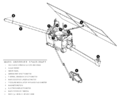Template:Selected anniversaries/August 21: Difference between revisions
No edit summary |
No edit summary |
||
| Line 4: | Line 4: | ||
File:Hubert Gautier.jpg|link=Hubert Gautier (nonfiction)|1660: Physician, mathematician, and engineer [[Hubert Gautier (nonfiction)|Hubert Gautier]] dies. He authored the first book on bridge building, ''Traité des Ponts'', in 1716, as well as books on roads, fortifications, antiquities, geology, and a first manual for watercolor practitioners. | File:Hubert Gautier.jpg|link=Hubert Gautier (nonfiction)|1660: Physician, mathematician, and engineer [[Hubert Gautier (nonfiction)|Hubert Gautier]] dies. He authored the first book on bridge building, ''Traité des Ponts'', in 1716, as well as books on roads, fortifications, antiquities, geology, and a first manual for watercolor practitioners. | ||
||1665: Giacomo F. Maraldi born ... astronomer and mathematician. | ||1665: Giacomo F. Maraldi born ... astronomer and mathematician. ... discovery ... the ice caps on Mars are not exactly on the rotational poles of that body. Maraldi is also credited for the first observation (1723) of what is usually referred to as Poisson's spot, an observation that was unrecognized until its rediscovery in the early 19th century by Dominique Arago. At the time of Arago's discovery, Poisson's spot gave convincing evidence for the contested wave nature of light. No pic online: https://www.google.com/search?q=Giacomo+F.+Maraldi | ||
||1673: Reinier de Graaf dies ... physician who discovered the follicles of the ovary (known as Graafian follicles), in which the individual egg cells are formed (1672) and also published on male reproductive organs (1668). He was also important for his studies on pancreatic juice (1663) and on the reproductive organs of mammals. He is considered one of the creators of experimental physiology. He used a technique of injecting dye into organs in order to be able to observe them better. It was on this technique that a bitter priority dispute with Swammerdam developed. He wrote a brief tract on the use of the syringe in anatomy (1669). He died, perhaps by suicide, at only 32 years of age. Pic. | ||1673: Reinier de Graaf dies ... physician who discovered the follicles of the ovary (known as Graafian follicles), in which the individual egg cells are formed (1672) and also published on male reproductive organs (1668). He was also important for his studies on pancreatic juice (1663) and on the reproductive organs of mammals. He is considered one of the creators of experimental physiology. He used a technique of injecting dye into organs in order to be able to observe them better. It was on this technique that a bitter priority dispute with Swammerdam developed. He wrote a brief tract on the use of the syringe in anatomy (1669). He died, perhaps by suicide, at only 32 years of age. Pic. | ||
| Line 64: | Line 64: | ||
||1993: Contact was lost with the Mars Observer spacecraft, following the pressurization of the rocket thruster fuel tanks, three days before it was to begin orbiting the Red Planet. The Mars Observer was to be the first U.S. spacecraft to study Mars since the Viking missions 18 years earlier. The fate of the $980 million mission remains unknown, though a commission studied possible causes for the failure. | ||1993: Contact was lost with the Mars Observer spacecraft, following the pressurization of the rocket thruster fuel tanks, three days before it was to begin orbiting the Red Planet. The Mars Observer was to be the first U.S. spacecraft to study Mars since the Viking missions 18 years earlier. The fate of the $980 million mission remains unknown, though a commission studied possible causes for the failure. | ||
||2012: William Thurston | ||2012: William Thurston dirs ... mathematician and academic ... a pioneer in the field of low-dimensional topology. In 1982, he was awarded the Fields Medal for his contributions to the study of 3-manifolds. Pic. | ||
||2017: Great American Eclipse traverses the continental United States. | ||2017: Great American Eclipse traverses the continental United States. | ||
Revision as of 06:04, 14 February 2019
1560: The occurrence at the predicted time of a solar eclipse in Copenhagen turns Tycho Brahe towards a life of observational astronomy.
1660: Physician, mathematician, and engineer Hubert Gautier dies. He authored the first book on bridge building, Traité des Ponts, in 1716, as well as books on roads, fortifications, antiquities, geology, and a first manual for watercolor practitioners.
1910: Astrophysicist, astronomer, and mathematician Subrahmanyan Chandrasekhar born. He will share the 1983 Nobel Prize for Physics "for his theoretical studies of the physical processes of importance to the structure and evolution of the stars".
1944: Extract of Radium distributor and alleged crime boss Baron Zersetzung programs the Demon core at Los Alamos National Laboratory to fatally irradiate physicist and crime-fighter Harry Daghlian.
1945: Physicist Harry Daghlian is fatally irradiated in a criticality accident during an experiment with the Demon core at Los Alamos National Laboratory.
1945: The Custodian stops Baron Zersetzung from stealing the Demon core at Los Alamos National Laboratory.
1993: NASA loses contact with the Mars Observer.
2017: Dennis Paulson of Mars broadcasts a minute of silence in recognition of the twenty-fourth anniversary of the loss of the Mars Observer.
2018: Toilet Bowl on the White House Lawn created.








